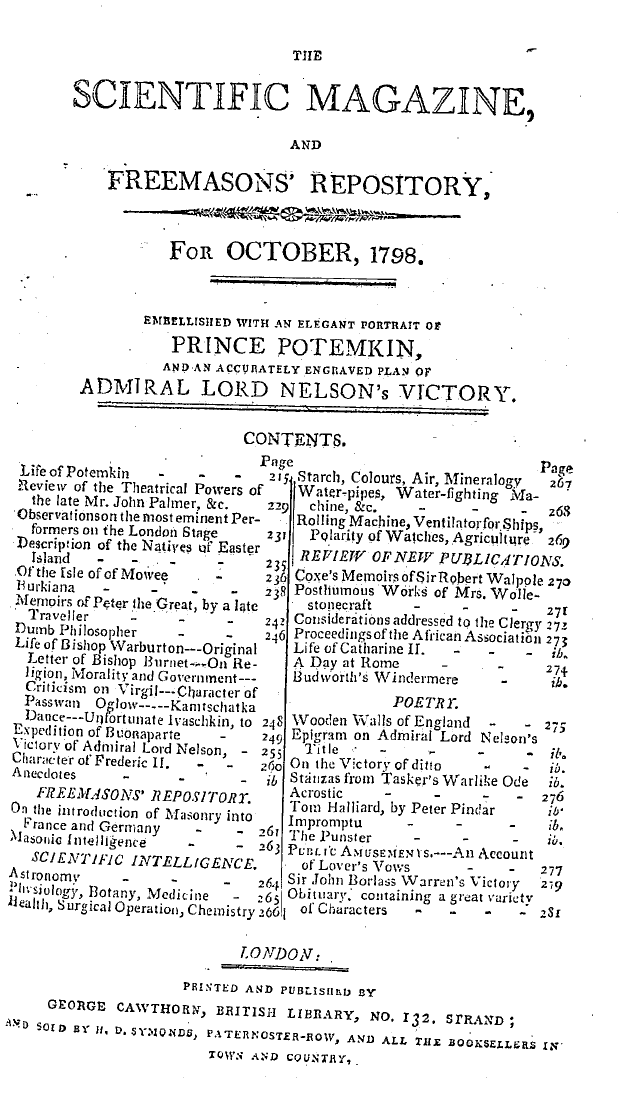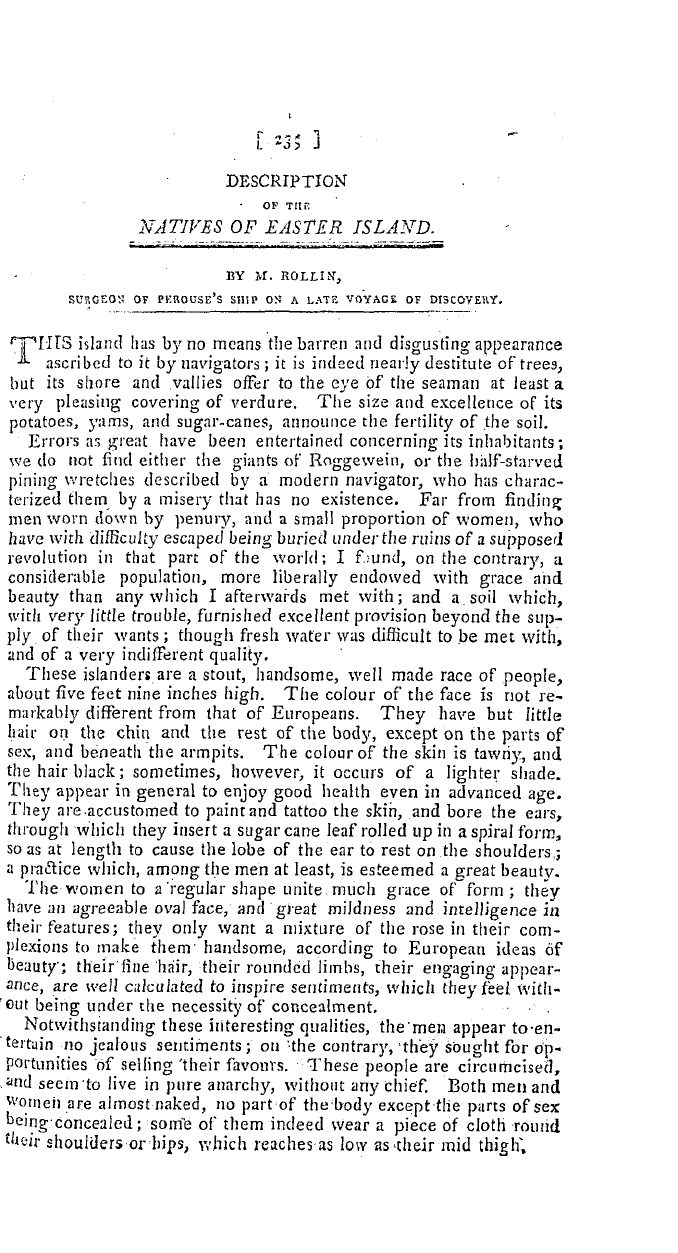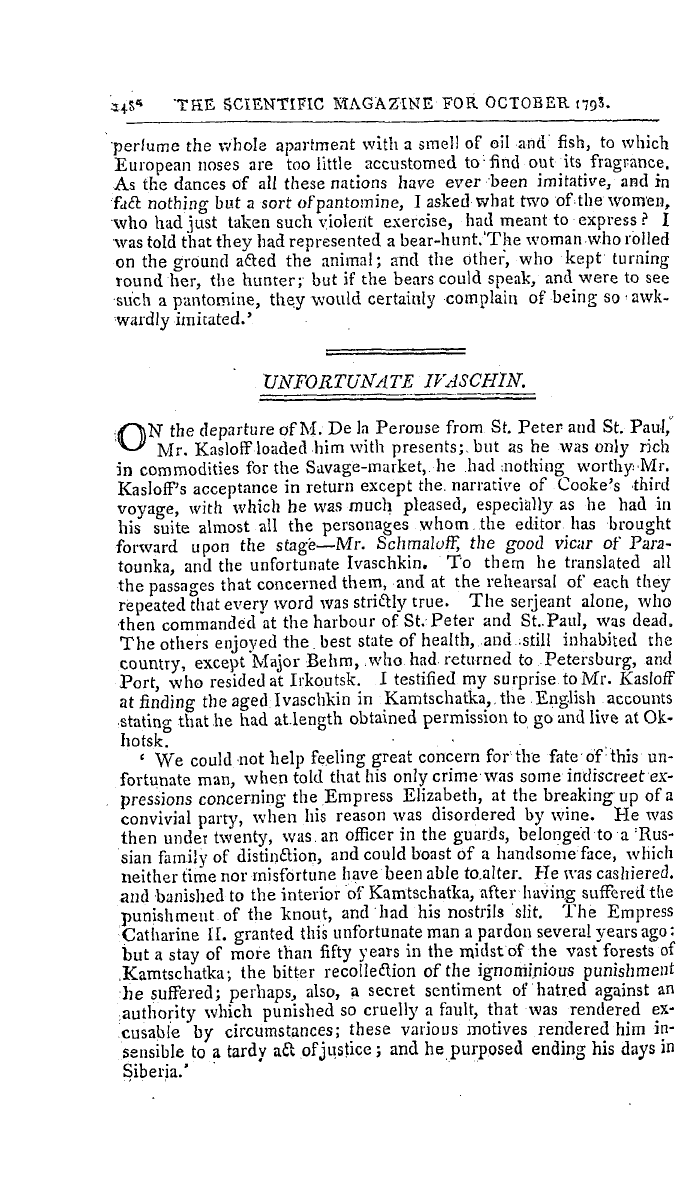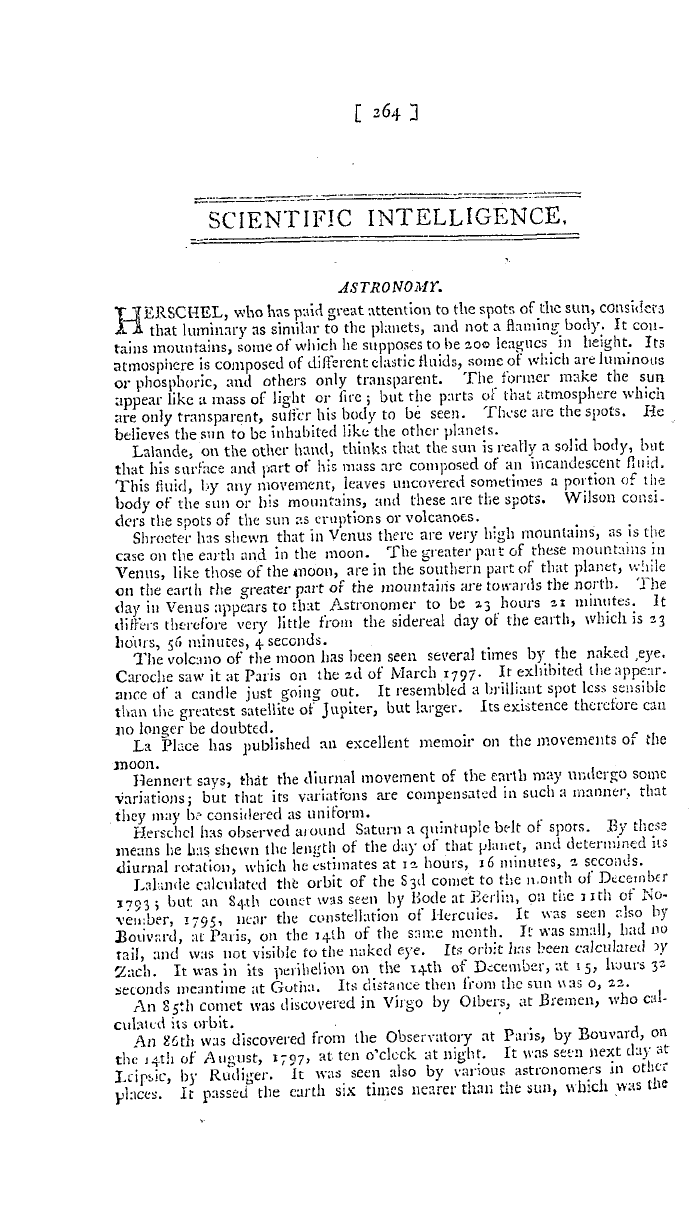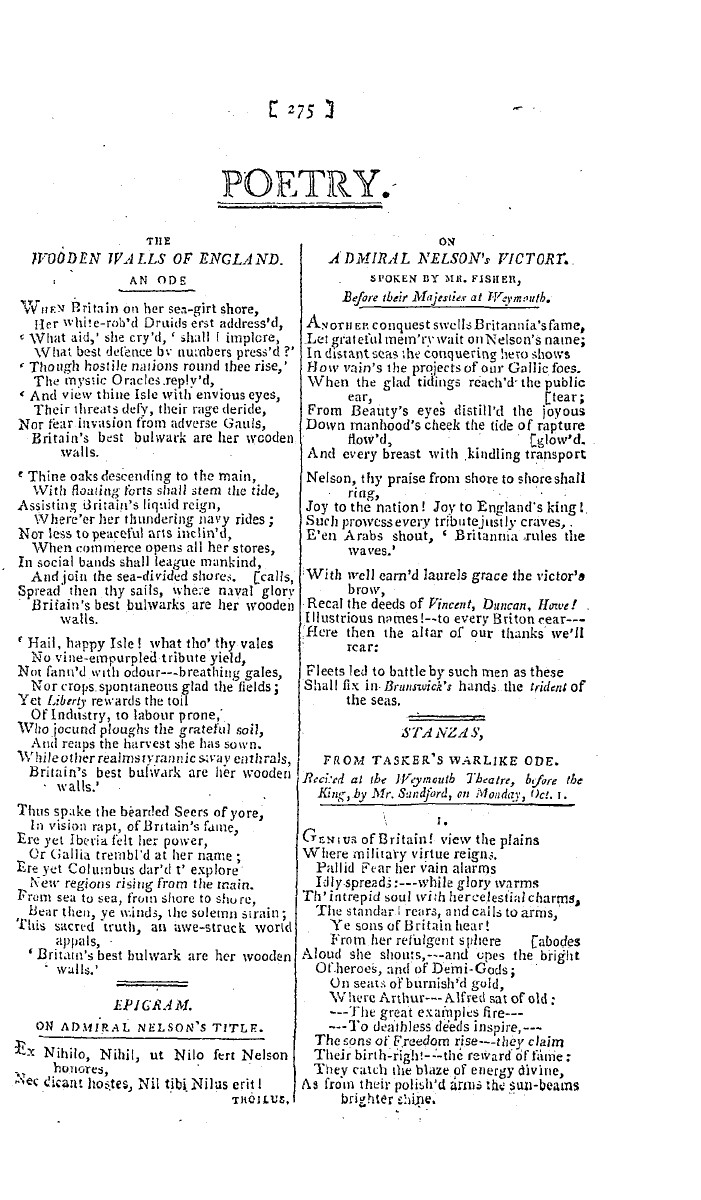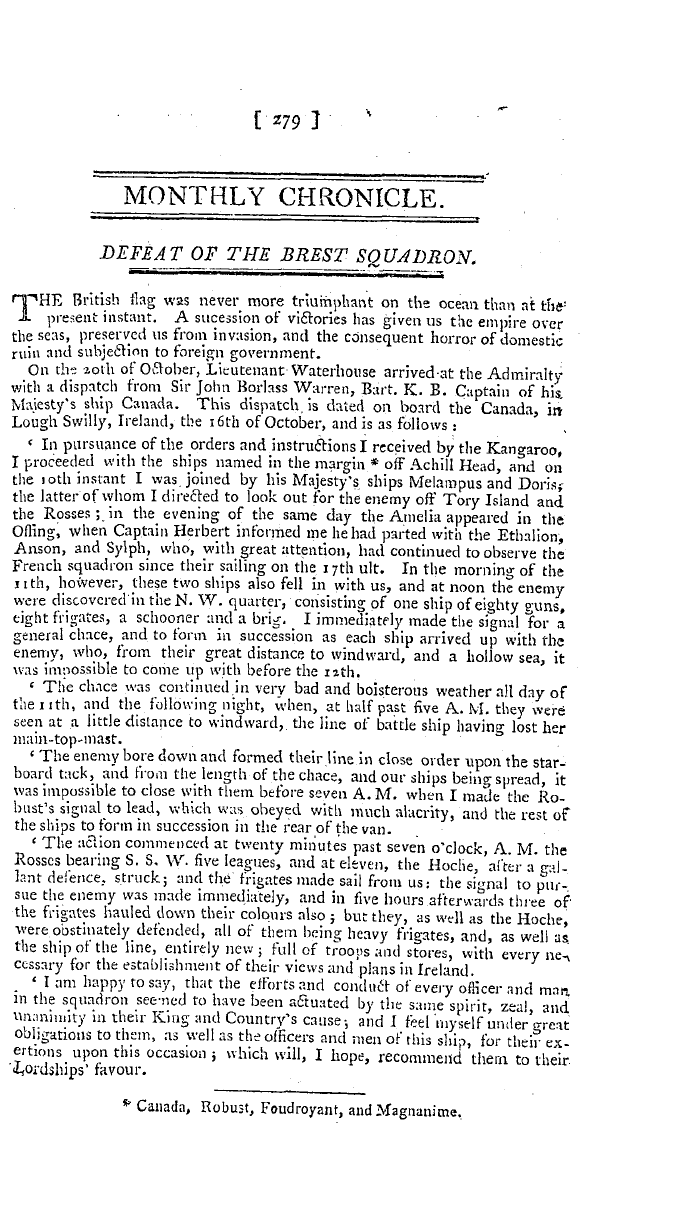-
Articles/Ads
Article SCIENTIFIC INTELLIGENCE. Page 1 of 6 →
Note: This text has been automatically extracted via Optical Character Recognition (OCR) software.
Scientific Intelligence.
SCIENTIFIC INTELLIGENCE .
ASTRONOMY . TJERSCHEL , who has paid great attention to the spots of the sun , considers ATI that luminary as similar to the planets , and not a flaming- body . It contains mountains , someof which he supposes to be 200 leagues in height . Its atmosphere is composed of different elastic fluids , some of which are luminous or phosphoric , and others only transparent . The former make the sun like of liht or fire but the parts ol that atmosphere which
appear a mass g ; are only transparent , suffer bis body to be seen . These are the spots . He believes the sun to be inhabited like the other planets . Lalande , on the other hand , thinks that the sun is really a solid body , but that his surface and part of his mass arc composed of an incandescent fluid . This fluid , by any movement , leaves uncovered sometimes a portion of the body of the sun or his mountains , and these are the spots . Wilson considers the snots of the sun as eruptions or volcanoes .
Shrocter has shewn that in Venus there are very high mountains , as is the case on the earth and in the moon . The greater pai t of these mountains in Venus , like those of the moon , are in the southern part of that planet , while on the earth the greater part of the mountain ' s are towards the north . ' 1 he day in Venus appears to that Astronomer to be 23 hours 21 minutes . It differs therefore very little from the sidereal day of the earth , which is 13 hours 5 ( 1 minute 4 seconds
, s , . _ The volcano of the moon has been seen several times by the naked , eye . Caroche saw it at Paris on the 2 d of March 1797 . It exhibited the appearance of a candle just going out . It resembled a brilliant spot less sensible than the greatest satellite of Jup iter , but larger . Its existence therefore can no longer be doubted . La Place has published an excellent memoir on the movements 01 the
moon . . Hennert says , that the diurnal movement of the earth may undergo some variations ; but that its variations are compensated in such a manner , that they may h < - considered as uniform . . H . pr--chcl Ins observed aiound Saturn a quintuple belt of spots , by these means he has shewn the length of the day of that planet , and determined its diurnal rotation , which he estimates at u hours , 16 minutes , a seconds . Lalande calculated the orbit of the S d comet to the month of December
j 703 ; but an 84-th comet was seen by Bode at Berlin , on the nth of November , ' - c , near the constellation of " Hercules . It was seen r ., so by Boiiviu-d , at Paris , on the 141 I 1 of the same month . If was small , had no tail , and was not visible to the naked eye . Its orbit has been calculated iy Zach . It was in its perihelion on the i + th of December , at 15 , haurs 3-seconds meantime at Gutha . Its distance then from the sun was o , 22 . An 85 th comet was discovered in Virgo by Gibers , at Bremen , who
calculated its orbit . . , , An 86 th was discovered from the Observatory at Pans , by Bouvard , on the 14 th of August , i ; 97 > * t ten o'clock at nig ht . It was seen next day < . t I . ripsic , by Rudiger . It was seen also by various astronomers in ots . t . p l-icc--. It passed the earth six times nearer than the sun , which was Uie
Note: This text has been automatically extracted via Optical Character Recognition (OCR) software.
Scientific Intelligence.
SCIENTIFIC INTELLIGENCE .
ASTRONOMY . TJERSCHEL , who has paid great attention to the spots of the sun , considers ATI that luminary as similar to the planets , and not a flaming- body . It contains mountains , someof which he supposes to be 200 leagues in height . Its atmosphere is composed of different elastic fluids , some of which are luminous or phosphoric , and others only transparent . The former make the sun like of liht or fire but the parts ol that atmosphere which
appear a mass g ; are only transparent , suffer bis body to be seen . These are the spots . He believes the sun to be inhabited like the other planets . Lalande , on the other hand , thinks that the sun is really a solid body , but that his surface and part of his mass arc composed of an incandescent fluid . This fluid , by any movement , leaves uncovered sometimes a portion of the body of the sun or his mountains , and these are the spots . Wilson considers the snots of the sun as eruptions or volcanoes .
Shrocter has shewn that in Venus there are very high mountains , as is the case on the earth and in the moon . The greater pai t of these mountains in Venus , like those of the moon , are in the southern part of that planet , while on the earth the greater part of the mountain ' s are towards the north . ' 1 he day in Venus appears to that Astronomer to be 23 hours 21 minutes . It differs therefore very little from the sidereal day of the earth , which is 13 hours 5 ( 1 minute 4 seconds
, s , . _ The volcano of the moon has been seen several times by the naked , eye . Caroche saw it at Paris on the 2 d of March 1797 . It exhibited the appearance of a candle just going out . It resembled a brilliant spot less sensible than the greatest satellite of Jup iter , but larger . Its existence therefore can no longer be doubted . La Place has published an excellent memoir on the movements 01 the
moon . . Hennert says , that the diurnal movement of the earth may undergo some variations ; but that its variations are compensated in such a manner , that they may h < - considered as uniform . . H . pr--chcl Ins observed aiound Saturn a quintuple belt of spots , by these means he has shewn the length of the day of that planet , and determined its diurnal rotation , which he estimates at u hours , 16 minutes , a seconds . Lalande calculated the orbit of the S d comet to the month of December
j 703 ; but an 84-th comet was seen by Bode at Berlin , on the nth of November , ' - c , near the constellation of " Hercules . It was seen r ., so by Boiiviu-d , at Paris , on the 141 I 1 of the same month . If was small , had no tail , and was not visible to the naked eye . Its orbit has been calculated iy Zach . It was in its perihelion on the i + th of December , at 15 , haurs 3-seconds meantime at Gutha . Its distance then from the sun was o , 22 . An 85 th comet was discovered in Virgo by Gibers , at Bremen , who
calculated its orbit . . , , An 86 th was discovered from the Observatory at Pans , by Bouvard , on the 14 th of August , i ; 97 > * t ten o'clock at nig ht . It was seen next day < . t I . ripsic , by Rudiger . It was seen also by various astronomers in ots . t . p l-icc--. It passed the earth six times nearer than the sun , which was Uie
